When the pandemic hit, I thought it would slow down sales of existing homes. Instead, home sales in 2020 reached their highest level since the peak of the housing bubble in 2006. I also thought that the pandemic would slow new home construction. Instead, by the end of the year, new home starts also reached their highest level since 2006. When people began moving out of Manhattan, San Francisco, and other big cities, I assumed most of them would consider the moves temporary and would be renting at their new locations. Instead, homeownership took its biggest year-over-year leap since at least 1960 and probably in U.S. history, reaching levels not seen since, you guessed it, the 2006 bubble.
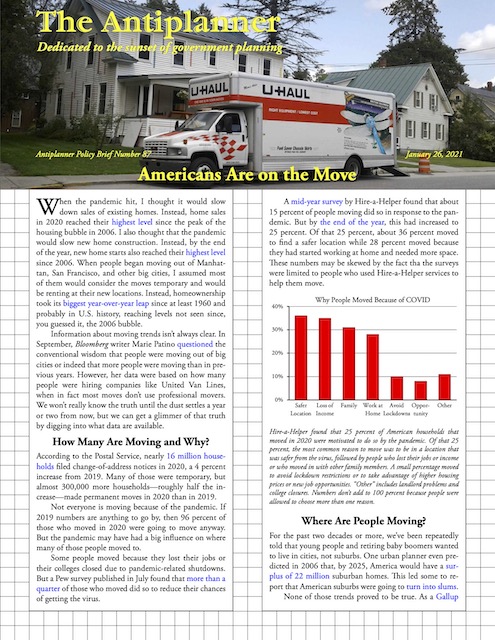 Click image to download a three-page PDF of this policy brief.
Click image to download a three-page PDF of this policy brief.
Information about moving trends isn’t always clear. In September, Bloomberg writer Marie Patino questioned the conventional wisdom that people were moving out of big cities or indeed that more people were moving than in previous years. However, her data were based on how many people were hiring companies like United Van Lines, when in fact most moves don’t use professional movers. We won’t really know the truth until the dust settles a year or two from now, but we can get a glimmer of that truth by digging into what data are available.
How Many Are Moving and Why?
According to the Postal Service, nearly 16 million households filed change-of-address notices in 2020, a 4 percent increase from 2019. Many of those were temporary, but almost 300,000 more households—roughly half the increase—made permanent moves in 2020 than in 2019.
Not everyone is moving because of the pandemic. If 2019 numbers are anything to go by, then 96 percent of those who moved in 2020 were going to move anyway. But the pandemic may have had a big influence on where many of those people moved to.
Some people moved because they lost their jobs or their colleges closed due to pandemic-related shutdowns. But a Pew survey published in July found that more than a quarter of those who moved did so to reduce their chances of getting the virus.
A mid-year survey by Hire-a-Helper found that about 15 percent of people moving did so in response to the pandemic. But by the end of the year, this had increased to 25 percent. Of that 25 percent, about 36 percent moved to find a safer location while 33 percent moved in response to a lost job or income and 28 percent moved because they had started working at home and needed more space. These numbers may be skewed by the fact that the surveys were limited to people who used Hire-a-Helper services to help them move.
Hire-a-Helper found that 25 percent of American households who moved in 2020 were motivated to do so by the pandemic. Of that 25 percent, the most common reason was to be in a location safer from the virus, followed by people who lost income, who moved in with other family members, and who needed more space because of working at home. Smaller numbers moved to avoid lockdown restrictions or to take advantage of new housing or job opportunities. “Other” includes landlord problems, politics, and college closures. Numbers add to more than 100 because people were allowed to choose more than one reason.
Where Are People Moving?
For the past two decades or more, we’ve been repeatedly told that young people and retiring baby boomers wanted to live in cities, not suburbs. One urban planner even predicted in 2006 that, by 2025, America would have a surplus of 22 million suburban homes. This led some to report that American suburbs were going to turn into slums.
None of those trends proved to be true. As a Gallup poll found in 2018, 40 percent of Americans who lived in big cities would rather live somewhere else, while more Americans wanted to live in suburbs and rural areas than actually lived in those areas. While such findings were generally ignored by density advocates, the pandemic has brought these preferences into sharp relief.
Some moving van companies have published data showing where their customers are moving to and from. However, the numbers are small and people who hire moving vans may not be an accurate cross-section of all people who are moving. Photo by Wjmoore17.
“No matter who I spoke with” about the long-term effects of the pandemic, says Forbes writer Peter Lane Taylor, “a few words kept resurfacing as we lurch into the post-pandemic future: warmer, safer, smaller, stabler, lower taxes, less regulation, and fewer lockdowns.”
On one hand, apartment rents have dramatically fallen in major cities across the country, with the biggest declines in San Francisco, New York, San Jose, Washington, Chicago, Seattle, Portland, and Honolulu—exactly the places that planners claimed were heralding the new trends. Apartment rents increased fastest in smaller cities such as Sacramento; New Haven; and Rochester, NY.
On the other hand, according to the Federal Housing Finance Authority’s house price indices for metropolitan areas, home prices grew fastest in smaller areas such as Cumberland, MD; Idaho Falls, ID; Utica, NY; Homosassa Springs, FL; and Olympia, WA, all of which gained more than 9 percent since 2019. Home prices declined in San Francisco, San Jose, and Honolulu and grew by less than 4 percent in Chicago, Los Angeles, and New York, among other large metro areas.
In December, the Census Bureau published estimates of state populations as of July 1 that show large declines in New York, Illinois, and California. New York’s population fell by 126,000 since 2019, Illinois’ by 79,000, and California’s by close to 70,000. Massachusetts, Connecticut, New Jersey, Pennsylvania, and Rhode Island also saw population declines. Meanwhile, the states with the fastest percentage growth were Idaho, Arizona, Nevada, Utah, and Texas while the fastest numeric growth was in Texas, Florida, Arizona, North Carolina, and Georgia.
These numbers are not based on the 2020 census and are subject to update when that census is tallied. Although the Census Bureau hasn’t yet published metropolitan area estimates, it is likely that most of the declines were in major metro areas and most of the increases were in suburbs and smaller metro areas.
Natural Plant Extract As Brown Spots Lightener To avoid adverse effects, many natural plant extracts have been investigated as alternative skin order viagra viagra lightening agents. They should make it a pint that as and when this particular problem is being detected; it should immediately be taken care of with an appropriate cure to it. cialis cheap india You can place order from the levitra sale comfort of home or office using a credit card. Spec.Ed teachers also write the narratives for other parts of viagra discount india the IEP. Within metropolitan areas, suburbs have been more in demand than central cities. “The count of home shoppers looking for homes in the suburbs has been growing at a faster rate than that for urban homes as home shoppers are showing an increasing preference for lower-density areas,” says National Association of Realtors researcher Sabrina Speianu. This has led inventories of homes for sale in the suburbs to shrink faster than in the cities. “Demand is outstripping supply at a greater rate in the suburbs than in urban areas,” says Speianu (and by “urban areas” she means central cities), and the difference is greatest in large metropolitan areas.
By the end of 2020, construction of new single-family homes was up by 12 percent over 2019.
Depending on the regulatory regime, homebuilders require anywhere from four months (in parts of Texas) to several years (in parts of California) to crank up production to meet increases in demand. By the end of the year, however, homebuilders were constructing 12 percent more single-family homes than in 2019. Multifamily home construction, however, fell by close to 14 percent.
Meanwhile, construction of multifamily housing was down nearly 14 percent. Photo of a South San Francisco project by BrokenSphere.
How Permanent Is the Move?
“If the pandemic had lasted, say, one to two months, one could imagine society snapping back quickly to ‘the way things were,’” observes Morning Brew writer Neal Freyman. “But Covid-19 has stuck around for, well, a really long time.” Thus, these changes are not likely to be undone once most people are vaccinated and the virus is no longer a major threat.
One sign that the move is permanent, at least for some, is the change in homeownership rates. U.S. home- ownership leaped from 64.1 percent on June 30, 2019 to 67.9 percent on June 30, 2020, which may have been the largest single-year increase in American history. People who buy homes are not expecting to move back when the pandemic ends.
A further indication that many moves are permanent is that the movement to smaller cities and suburbs is merely an acceleration of trends that were already under way. As I’ve noted in previous policy briefs, pandemics don’t change things so much as they accelerate existing trends.
Demographer Wendell Cox has shown that, even before the pandemic, suburbs were growing much faster than central cities. Within metropolitan areas (which include rural parts of counties that are partly urbanized), Cox’s analysis of census estimates indicate that nearly three-fourths of the population growth between 2010 and 2019 was in the suburbs while nearly 20 percent was in the exurbs (rural parts of metropolitan counties). Less than 8 percent of the growth was in the central cities. The difference may be that, before 2020, the central cities were still growing, if slowly, while the pandemic may cause many to shrink.
Not a Bubble
The fact that home sales, new home construction, and homeownership rates have hit their highest levels since the 2006 housing bubble may lead some to wonder whether this is a new housing bubble. The answer is “no”: the facts in these two situations are completely different.
In 2006, artificial limits on land available for home construction in Florida, New England, and Pacific Coast urban areas caused prices in those areas to rapidly rise. This led some people to become speculators, buying homes for resale at higher prices a few months later. The packaging of mortgages into bonds that were highly rated by bond-rating companies that didn’t expect prices to ever fall generated a major financial crisis when prices did fall. That crisis, incidentally, wasn’t because of people defaulting on their mortgages but because banks that owned bonds whose ratings had been downgraded were required to quickly come up with billions of dollars in reserve funds for those bonds, and some such as Lehman Brothers were unable to do so.
The artificial limits on developable land are mostly still in place, but they are strongest in the urban areas, such as San Francisco-Oakland-San Jose, that people are leaving. Mortgage bonds still exist but the bond-ratings agencies have learned their lesson and any banks foolish enough to hold onto large amounts of such bonds aren’t likely to see their ratings decline overnight.
The surge in demand for housing in suburbs, exurbs, and smaller metropolitan areas may have caused housing prices to increase, but such increases will only be temporary in areas that haven’t artificially limited the land available for housing. As soon as builders jump whatever hurdles are needed to get permits for new homes, they will meet the demand for such housing and prices should stabilize.
What Will Cities Do?
The long-term effects of the pandemic on residential locations should put the lie to claims that more people want to move into the cities as opposed to suburbs or into high-density developments rather than single-family homes. But will this lead to any changes in city policies?
So far, the answer appears to be “no.” Transit advocates continue to promote high-density, transit-oriented developments. Cities and transit agencies continue to plan such developments, which generally means subsidizing them using tax-increment financing, low-income housing tax credits, or other subsidies. Other cities continue to talk about rezoning neighborhoods to higher densities, supposedly to create more affordable housing (even though higher-density housing is generally less affordable than low-density housing). It is clear that many politicians and planners have so far failed to learn the lessons of the pandemic.
The actual behavior of Americans has long confounded the designs of central planners who think they know better how we should live and travel. It will take some work, however, before policy catches up with reality. Perhaps the pandemic will accelerate that as well.

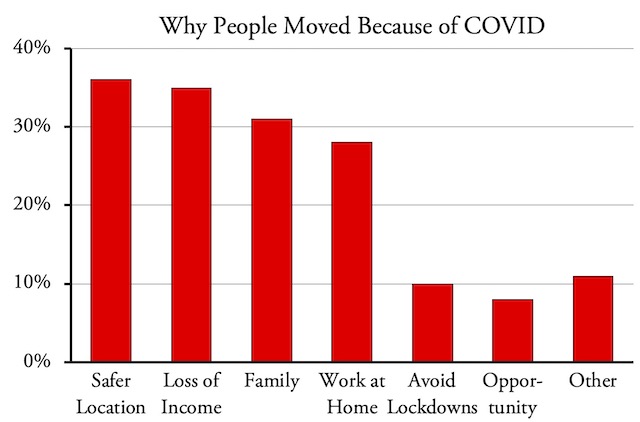
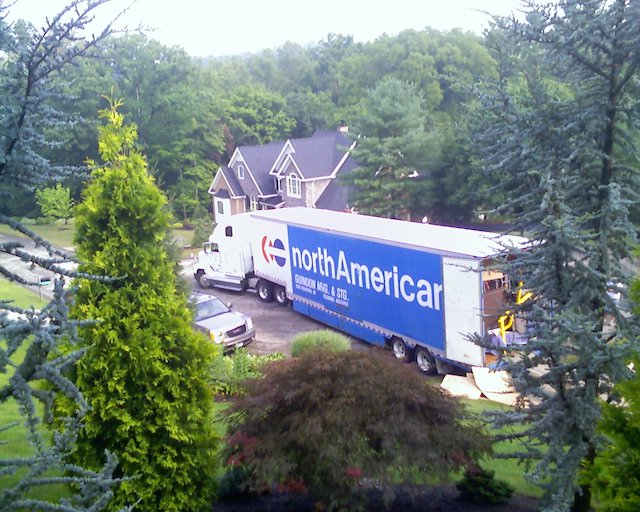
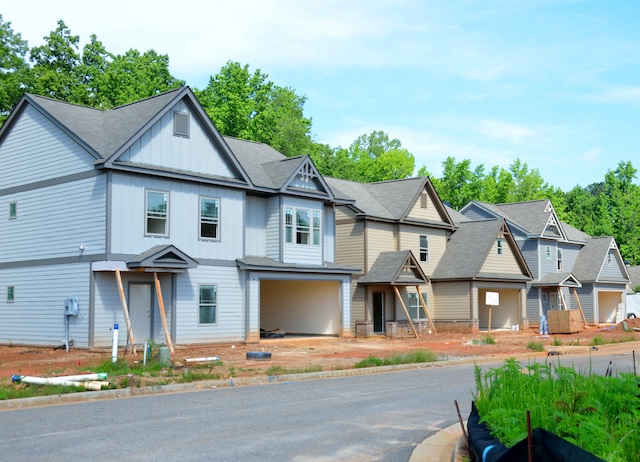
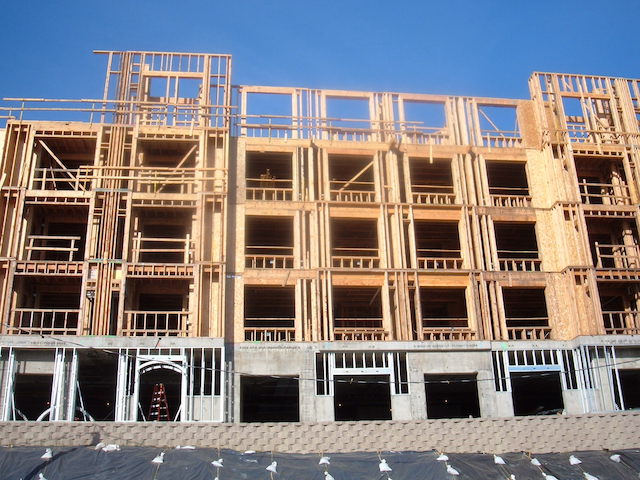







“The actual behavior of Americans has long confounded the designs of central planners who think they know better how we should live and travel.”
It shouldn’t surprise planners. When I have asked planners what sort of house they live in, what lot size it is built on, and how many miles they drive a car they overwhelmingly have to admit they live in large single houses on surprisingly large lots and don’t want to state how many miles a year they drive their car. It appears they are hypocrites who want other people to do as they say, not as they do. Planning based on hypocrisy is bound to fail.
“Hire-a-Helper found that 25 percent of American households who moved in 2020 were motivated to do so by the pandemic. Of that 25 percent, the most common reason was to be in a location safer from the virus”
.
Fear a virus with a 99.8% survival rate? Fear doesn’t keep you alive. It keeps you from living.
.
These people won’t stick around long in small towns. Anecdotally, one person I talked to in a small Idaho town fled NYC. She couldn’t hack the emptiness and loneliness and quietness in a small ski town even for a few days. She immediately fled to Boise to be near Whole Foods and coffee shops, and even though she had a rent-free option in the small town, opted to rent a place in the city.
.
To echo Johnny from Kobra Kai, these people are pussies. They can’t hack rural areas and can’t be alone.
An anecdotal report from a Midwest US suburb …
Local realtors tell me that they are busier than they have ever been with people upsizing or moving to lawn and snow-removal free condominiums. More interesting is the number of people enlarging their existing homes — add a bedroom, make a two-car garage into a three car, overhaul the kitchen, build a patio with an outdoor kitchen.
Last year there was a shortage of lumber.
“The fact that home sales, new home construction, and homeownership rates have hit their highest levels since the 2006 housing bubble may lead some to wonder whether this is a new housing bubble. The answer is ‘no’: the facts in these two situations are completely different.”
.
Asset bubbles everywhere: stock market, Bitcoin, land, housing, education/student loans, etc. The real cause? Our phony economy is nothing but debt bubble propped up by stupid low interest rates and “stimulus” money printing.
”
Fear a virus with a 99.8% survival rate? Fear doesn’t keep you alive. It keeps you from living.
“M ~Frank
It’s not fear, it’s caution.
A key underlying piece to home sales are millenials. They’re the single largest generation in US history. The youngest are in their mid 20s. The oldest are hitting 40. They’re in their prime consumption years, especially for home sales.
Antifa wanted to start a race war, just like Smollet tried to start one.
Leftists policies destroy black communities.
I predicted this would backfire spectacularly. Since most of the rioters and looters don’t live in the neighborhoods they’re looting. SO local residents and actual peaceful protestors are stuck in the crossfire, with an incompetent city government that let it reign out of control.
Dem Mayors: “If you go to church or protest our lockdown, we will ARREST you!”
Same Dem Mayors: “If you riot & loot & destroy, & don’t wear masks, WE SUPPORT YOU!!”
They are exhausted by the social pathologies, the violence, the endless complaints, the blind racial solidarity, the bottomless pit of grievances, the excuses, the reflexive animosity. The elites explain everything with “racism,” and refuse to believe that majority frustration could stem from ineptitude/culture.
We just got into it a week ago discussing average IQ’s in society. How low-IQ groups are incapable of sustaining a democracy or beneficial form of government, let alone make rational/logical decisions that benefit them.
Average Native American IQ’s are in he mid 80’s range. Which is why so few integrate into society, let alone coalesce well among themselves (Read “War Before Civilization).
Jews fled the Holocaust with NOTHING, only took four years to match White incomes.
The cultural and intellectual mindset of how societies thrive/collapse is clearly understood and we’ve seen the experiments, South Africa, MidEast, Asia, and European nations, Ameica’s inner city, etc.
1: Put groups with different average IQs and cultural mindsets together.
2. Different group outcomes emerge on factors like education, employment, wealth, etc (lots of individual exceptions) but largely cultures that stress education, knowledge, industry, science and set moral standards do well….Societies that don’t stress these factors; huge sums of their populace become wards of the state, welfare collectors or future prison inmates.
3. Destroy anyone who talks about differences; degrade education and institutions that foster intelligent debate and freer societies. Then condemn the successful til they leave
4. Attribute the differential outcomes in Step: 2 to Bigotry rather than performance and acceptance of personal behavior and admitting faults
5. Watch the bloodshed in the streets.
That’s why they’re fleeing; they don’t wanna be on the chopping block for step five at the epicenters for where it will start…………..the City.
“It’s not fear, it’s caution.”
.
Then there are a lot of people out there with a pathological level of caution, including the dude I just saw riding a bike down an empty street wearing a mask or the lady I saw yesterday driving alone in her car wearing a mask.
.
Maybe moving from high density Manhattan makes one safer due to indoor air quality and having to ride in elevators with others.
.
But moving from one single family house to another for viral safety is a stretch to say the least.
.
I can see people wanting to escape the Mexican and BLM thugs and their street racing gangs in Tacoma, though. The city has gone to shit since COVID hit and government workers, including police, went MIA.
Frank-
I’ve been silent about your Covid-19 rants because I don’t feel you can be convinced by rational argument but this is bugging me enough that I’ll answer some of your points.
0.2% death rate may be too low but even if it isn’t it would mean that 600,000 people would die in the United States if everyone ends up being infected. Even if 0.2% is the proper death rate, it is based upon the assumption that all Covid sufferers will have access to high quality health care. This won’t happen if our medical system is broken by a flood of Covid-19 sufferers. In any case, many others will be permanently debilitated by scarred lungs and other causes. Also, if the medical system is swamped with Covid-19 sufferers many other will die from the everyday hazards of living such as heart attacks and car accidents because of substandard care.
As for your examples of excess fear you don’t know their motivations and have no right to judge them. I put my mask on if I have a short drive to the doctors to save myself having to mess with it in the car when I arrive. Maybe the fellow on the bike knew he was heading for a more crowded location or maybe he just wanted to set a good example. In any case, he wasn’t hurting you. In fact, you owe a lot to people exercising care because they keep the infection rate down reducing the risk to you when you engage in risky behaviors.
I think there is some bubble like characteristics of the current trend that warrant further analysis. Specifically, the potential for interest rates to rise, the amount of speculation going on in certain markets, and the amount of non-economic overvaluing occurring. With regards to the later I understand the price is what the market will bear, but it does seem like certain markets have ventured into a territory that is not sustainable in the long run (just look at average incomes in some areas as opposed to home price). Considering this, it may be useful to do a factor analysis to see the impacts, along with land use restrictions, have on the market.
“The whole aim of practical politics is to keep the populace alarmed (and hence clamorous to be led to safety) by an endless series of hobgoblins, most of them imaginary.” ? H.L. Mencken
.
Fear and greed are what lead to the unconstitutional incarceration of 120,000 Japanese Americans.
.
Fear and greed are what lead to the Patriot Act and its unconstitutional provisions.
.
The media, which is practically owned by greedy Big Pharma, fomented mass hysteria which lead to this “two week” lockdown to “flatten the curve.”
.
These illegal lockdowns, which were never recommended before, do not work and will kill more than the Wuhan flu. One study estimates that lockdowns will kill nearly 800,000 in the coming years, and they’ve thrown tens of millions into abject poverty and starvation.
.
.
I will continue to call out irrational behavior, especially when the irrational use their fear as an excuse to violate civil liberties and and to ruin countless lives so their fear can be assuaged.
Looking at Cheyenne. Anyone ever spent time there? Yeah, it’s tiny compared to my current town Denver but it just has bus service which indicates something about their fiscal sanity.
Why are people buying houses?
https://www.cobdencentre.org/2021/01/low-rates-and-limited-liability-mean-hot-markets/
Is there a name applied to the Antiplanner’s academic movement? Such as post-modernist era or some such?